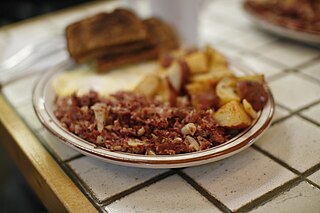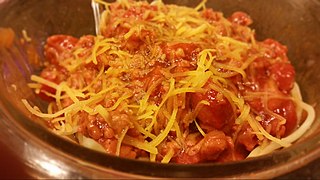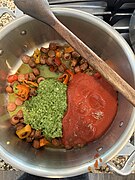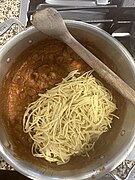
Tomato sauce can refer to many different sauces made primarily from tomatoes, usually to be served as part of a dish, rather than as a condiment. Tomato sauces are common for meat and vegetables, but they are perhaps best known as bases for sauces for Mexican salsas and Italian pasta dishes. Tomatoes have a rich flavor, high water content, soft flesh which breaks down easily, and the right composition to thicken into a sauce when stewed, without the need for thickeners such as roux or masa. All of these qualities make them ideal for simple and appealing sauces.

Pad thai, phat thai, or phad thai, is a stir-fried rice noodle dish commonly served as a street food in Thailand as part of the country's cuisine. It is typically made with rice noodles, shrimp, peanuts, a scrambled egg, and bean sprouts. The ingredients are fried in a wok.

Fried rice is a dish of cooked rice that has been stir-fried in a wok or a frying pan and is usually mixed with other ingredients such as eggs, vegetables, seafood, or meat. It is often eaten by itself or as an accompaniment to another dish. Fried rice is a popular component of East Asian, Southeast Asian and certain South Asian cuisines, as well as a staple national dish of Indonesia. As a homemade dish, fried rice is typically made with ingredients left over from other dishes, leading to countless variations. Fried rice first developed during the Sui Dynasty in China.

Hash is a dish consisting of chopped meat, potatoes, and fried onions. The name is derived from French: hacher, meaning 'to chop'. It originated as a way to use up leftovers. In the U.S. by the 1860s, a cheap restaurant was called a "hash house" or "hashery."

Rémoulade is a cold sauce. Although similar to tartar sauce, it is often more yellowish, sometimes flavored with curry, and often contains chopped pickles or piccalilli. It can also contain horseradish, paprika, anchovies, capers and a host of other items.
Sweet and sour is a generic term that encompasses many styles of sauce, cuisine, and cooking methods. It is commonly used in East Asia and Southeast Asia and has been used in England since the Middle Ages. Sweet and sour sauce remains popular in Asian and Western cuisines.

Cincinnati chili is a Mediterranean-spiced meat sauce used as a topping for spaghetti or hot dogs ("coneys"); both dishes were developed by immigrant restaurateurs in the 1920s. Its name evokes comparison to chili con carne, but the two are dissimilar in consistency, flavor, and serving method; Cincinnati chili more closely resembles Greek pasta sauces and spiced-meat hot dog topping sauces seen in other parts of the United States.

Koshary, kushari or koshari is Egypt's national dish and a widely popular street food. It is a traditional Egyptian staple, mixing pasta, Egyptian fried rice, vermicelli and brown lentils, and topped with a zesty tomato sauce, garlic vinegar and garnished with chickpeas and crispy fried onions. It is often served with sprinklings of garlic vinegar, and hot sauce is optional.

Czech cuisine has both influenced and been influenced by the cuisines of surrounding countries and nations. Many of the cakes and pastries that are popular in Central Europe originated within the Czech lands. Contemporary Czech cuisine is more meat-based than in previous periods; the current abundance of farmable meat has enriched its presence in regional cuisine. Traditionally, meat has been reserved for once-weekly consumption, typically on weekends.

Chili sauce and chili paste are condiments prepared with chili peppers.

Peanut sauce, satay sauce, bumbu kacang, sambal kacang, or pecel is an Indonesian sauce made from ground roasted or fried peanuts, widely used in Indonesian cuisine and many other dishes throughout the world.

Different areas of the world have local variations on the hot dog, in the type of meat used, the condiments added, and its means of preparation.

The cuisine of Senegal is a West African cuisine that derives from the nation's many ethnic groups, the largest being the Wolof. Islam, which first embraced the region in the 11th century, also plays a role in the cuisine. Senegal was a colony of France until 1960. From the time of its colonization, emigrants have brought Senegalese cuisine to many other regions.

Mie goreng, also known as bakmi goreng, is an Indonesian stir-fried noodle dish. It is made with thin yellow noodles stir-fried in cooking oil with garlic, onion or shallots, fried prawn, chicken, beef, or sliced bakso (meatballs), chili, Chinese cabbage, cabbages, tomatoes, egg, and other vegetables. Ubiquitous in Indonesia, it is sold by food vendors from street hawkers (warungs) to high-end restaurants.

Fried plantain is a dish cooked wherever plantains grow, from West Africa to East Africa as well as Central America, the tropical region of northern South America and the Caribbean countries like Haiti to Cuba and in many parts of Southeast Asia and Oceania, where fried snacks are widely popular. In Indonesia it is called gorengan. It is called dodo in Yoruba in South West Nigeria, otherwise known as simply fried plantain in other parts of Nigeria. Kelewele is a fried spicy plantain or can be fried as a side dish for Red Red and fish stew in Ghana.

Pakistani Chinese cuisine comprises the styles and variations of Chinese cuisine that are cooked and consumed in Pakistan. Chinese migrants to Pakistan have developed a distinct Pakistani-style Chinese cuisine.

A meatball is ground meat (mince) rolled into a ball, sometimes along with other ingredients, such as bread crumbs, minced onion, eggs, butter, and seasoning. Meatballs are cooked by frying, baking, steaming, or braising in sauce. There are many types of meatballs using different types of meats and spices. The term is sometimes extended to meatless versions based on vegetables or fish; the latter are also commonly known as fish balls.

Manchurian is a class of Indian Chinese dish made by roughly chopping and deep-frying ingredients such as chicken, cauliflower (gobi), prawns, fish, mutton, and paneer, and then sautéeing them in a sauce flavored with soy sauce. Manchurian is the result of the adaptation of Chinese cooking and seasoning techniques to suit Indian tastes. It has become a staple of Indian Chinese cuisine.

Filipino spaghetti is a Filipino adaptation of Italian spaghetti with Bolognese sauce. It has a distinctively sweet sauce, usually made from tomato sauce sweetened with brown sugar and banana ketchup. It is typically topped with sliced hot dogs or smoked longganisa sausages, giniling, and grated cheese. It is regarded as a comfort food in Philippine cuisine. It is typically served on almost any special occasion, especially on children's birthdays.

Barbecue spaghetti is a dish from Memphis, Tennessee, that combines spaghetti with a sauce made from shredded smoked pork or pulled pork, vegetables, and barbecue sauce. It is served as a side dish in some Memphis barbecue restaurants. Southern Living called the dish iconic and "perhaps the city's most unusual creation". HuffPost called it "a Memphis staple".























